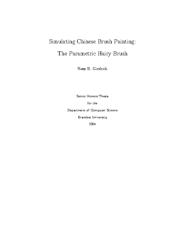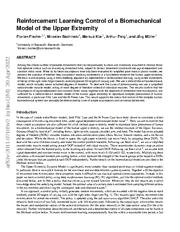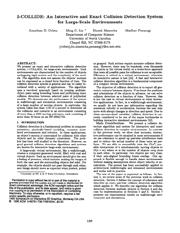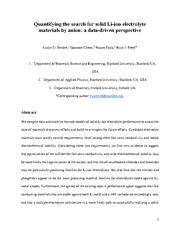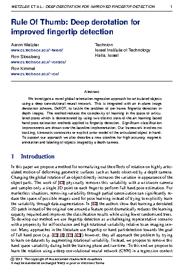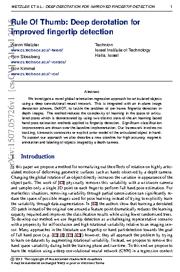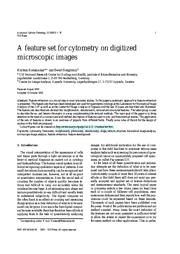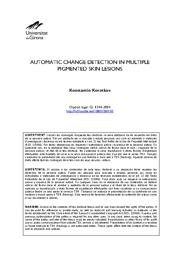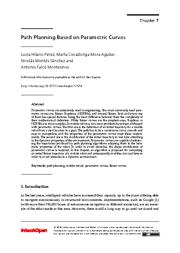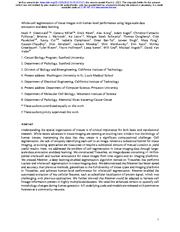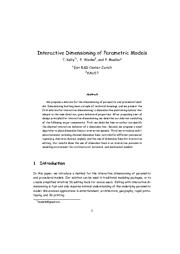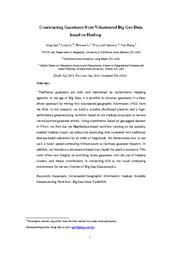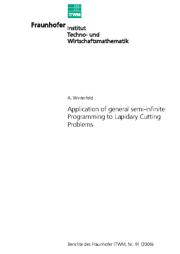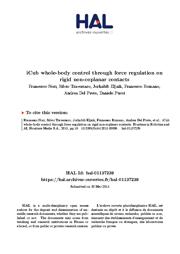A copy of this work was available on the public web and has been preserved in the Wayback Machine. The capture dates from 2009; you can also visit the original URL.
The file type is application/pdf.
Filters
Simulating Chinese brush painting
2004
ACM SIGGRAPH 2004 Posters on - SIGGRAPH '04
This paper proposes a new geometric model for simulating the structure and behavior of brushes used in traditional Chinese painting. ...
The geometric model uses a novel parametric representation of the internal structure of a real brush coupled with an intuitive approximation of soft brush dynamics suitable for use in a real-time painting ...
In addition to the convex hull property, Bézier curves are attractive because fast and easy to implement algorithms exist for evaluating them. ...
doi:10.1145/1186415.1186442
dblp:conf/siggraph/Girshick04
fatcat:tna2yqpe3ffbdf4qelay6etaj4
Reinforcement Learning Control of a Biomechanical Model of the Upper Extremity
[article]
2020
arXiv
pre-print
We learn a control policy using a motor babbling approach based on reinforcement learning, using aimed movements of the tip of the right index finger towards randomly placed 3D targets of varying size. ...
This result supports the idea that the control of the complex human biomechanical system is plausible to be determined by a set of simple assumptions and can be easily learned. ...
Acknowledgements We would like to thank Aldo A. Faisal (Imperial College London) for his very helpful advice and comments on the manuscript. ...
arXiv:2011.07105v1
fatcat:6bquzrvrz5hvri5ggvq7oj2bdu
Structure Tensor Based Analysis of Cells and Nuclei Organization in Tissues
2016
IEEE Transactions on Medical Imaging
Contrarily to segmentation methods which rely on an object based modelling of images, the structure tensor views the sample at a macroscopic scale, like a continuum. ...
A quantitative evaluation of the method is provided for synthetic and real 2D and 3D images. ...
Acknowledgement The authors would like to thank the TRI-Genotoul and ITAV-USR3505 image facilities and all the members of ITAV for providing a nice research environment. ...
doi:10.1109/tmi.2015.2470093
pmid:26292339
fatcat:wyufrij2ybbdth557lbpqx47o4
The algorithm uses a two-level approach based on pruning multipleobject pairs using bounding boxes and performing exact collision detection between selected pairs of polyhedral models. ...
The algorithm does not assume the objects' motions can be expressed as a closed form function of time. ...
ACKNOWLEDGEMENTS We are grateful to John Canny and David Baraff for productive discussions and to Brian Mirtich for his help in implementation of the convex polytope pair algorithm. ...
doi:10.1145/199404.199437
dblp:conf/si3d/CohenLMP95
fatcat:4ehyercrijfchiyjsjdsufjcvu
Quantifying the search for solid Li-ion electrolyte materials by anion: a data-driven perspective
[article]
2019
arXiv
pre-print
architecture is a more likely path to successfully realizing a solid-state Li metal battery by approximately an order of magnitude or more. ...
Furthermore, the spread of the existing data in performance space suggests that fast conducting materials that are stable against both Li metal and a >4V cathode are exceedingly rare, and that a multiple-electrolyte ...
Acknowledgements This work is supported in part by a seed grant from the TomKat Center for Sustainable
VII. References ...
arXiv:1904.08996v1
fatcat:6tmbplgkkjbmza3zhbflqg2gcm
Rule of thumb: Deep derotation for improved fingertip detection
2015
Procedings of the British Machine Vision Conference 2015
To support our approach we also describe a new pipeline for high accuracy magnetic annotation and labeling of objects imaged by a depth camera. ...
The method reduces the complexity of learning in the space of articulated poses which is demonstrated by using two distinct state-of-the-art learning based hand pose estimation methods applied to fingertip ...
We have found that a similar but more stable option is to determine an enclosing ellipse using a Procrustes like algorithm on the convex hull of the points V of the hand segmentation. ...
doi:10.5244/c.29.33
dblp:conf/bmvc/WetzlerSK15
fatcat:ajrdrqeifze7hmw3kjzdkoftxy
Rule Of Thumb: Deep derotation for improved fingertip detection
[article]
2015
arXiv
pre-print
To support our approach we also describe a new pipeline for high accuracy magnetic annotation and labeling of objects imaged by a depth camera. ...
The method reduces the complexity of learning in the space of articulated poses which is demonstrated by using two distinct state-of-the-art learning based hand pose estimation methods applied to fingertip ...
We have found that a similar but more stable option is to determine an enclosing ellipse using a Procrustes like algorithm on the convex hull of the points V of the hand segmentation. ...
arXiv:1507.05726v1
fatcat:oh7ecaaqyzhz7jh644oytxjx2y
A Feature Set for Cytometry on Digitized Microscopic Images
2003
Analytical Cellular Pathology
The latter group is used to describe the eu‐ and hetero‐chromatin in a way complementing the textural methods. ...
The main goal of the paper is to bring attention to the need of a common and well defined description of features used in cyto‐ and histometrical studies. ...
Convex hull, deficiency and elliptic deviation: The convex hull of an object is the smallest convex object that completely encloses the object. ...
doi:10.1155/2003/548678
pmid:12590175
pmcid:PMC4618906
fatcat:q7yio4jzunhfznifkzk4dgujzm
A New Total Body Scanning System for Automatic Change Detection in Multiple Pigmented Skin Lesions
2015
IEEE Transactions on Medical Imaging
In essence, these ratios represent one descriptor. e There are various descriptors based on the convex hull (CH) and bounding box (BB) of a lesion. ...
In essence, these ratios represent one descriptor. e There are various descriptors based on the convex hull (CH) and bounding box (BB) of a lesion. ...
doi:10.1109/tmi.2014.2357715
pmid:25222947
fatcat:kyheggjbdfggzi3vsv74niltpe
Path Planning Based on Parametric Curves
[chapter]
2018
Advanced Path Planning for Mobile Entities
In this chapter, an algorithm is proposed for computing an initial Bézier trajectory of a mobile robot and subsequently modifies it in real time in order to avoid obstacles in a dynamic environment. ...
The first one is the definition of an initial trajectory for a mobile robot from a start location to a goal. ...
This is due to the property of the convex hull and implies that if the control points are within the bubble, then the path approximation remains within the bubble. ...
doi:10.5772/intechopen.72574
fatcat:ygehl266ybayrcn6bmeo5hrueu
Whole-cell segmentation of tissue images with human-level performance using large-scale data annotation and deep learning
[article]
2021
bioRxiv
pre-print
We created Mesmer, a deep learning-enabled segmentation algorithm trained on TissueNet that performs nuclear and whole-cell segmentation in tissue imaging data. ...
We demonstrated that Mesmer has better speed and accuracy than previous methods, generalizes to the full diversity of tissue types and imaging platforms in TissueNet, and achieves human-level performance ...
Acknowledgments We thank Long Cai, Katy Borner, Matt Thomson, Steve Quake, and Markus Covert for interesting discussions; Sean Bendall, David Glass, and Erin McCaffrey for feedback on the manuscript; Roshan ...
doi:10.1101/2021.03.01.431313
fatcat:xob6ar7uwfh3bpuwowp2lvyp7u
Interactive Dimensioning of Parametric Models
2015
Computer graphics forum (Print)
Our results show the use of dimension lines in an interactive parametric modeling environment for architectural, botanical, and mechanical models. * ...
First, we describe how an author can specify the desired interactive behavior of a dimension line. Second, we propose a novel algorithm to place dimension lines at interactive speeds. ...
Second, we compute the 2D convex hull of the resulting points and lines on the ground plane. ...
doi:10.1111/cgf.12546
fatcat:d3rxorsyfbf43k4z3ttn62meba
Constructing Gazetteers from Volunteered Big Geo-Data Based on Hadoop
[article]
2014
arXiv
pre-print
In this research, we build a scalable distributed platform and a high-performance geoprocessing workflow based on the Hadoop ecosystem to harvest crowd-sourced gazetteer entries. ...
Using experiments based on geotagged datasets in Flickr, we find that the MapReduce-based workflow running on the spatially enabled Hadoop cluster can reduce the processing time compared with traditional ...
Goodchild for discussions, comments and guidance on this research; thank Shaowen Wang for the introduction of Cloudera ...
arXiv:1311.7676v2
fatcat:zz7ets43ovg5rpercmocf3hdv4
Application of general semi-infinite programming to lapidary cutting problems
2008
European Journal of Operational Research
Some numerical results based on realworld data are also presented. 1 2 4 ANTON WINTERFELD 1 Solving GSIP In this section, a solver for GSIP with convex lower level problems is briefly described. ...
The problem is formulated as a general semi-infinite program (GSIP ) and solved using an interiorpoint method developed by Stein. ...
on a fixed mesh and therefore leading to fast numerical algorithms. ...
doi:10.1016/j.ejor.2007.01.057
fatcat:6szzfosbgngsbhzmqpc3xac6ry
iCub Whole-Body Control through Force Regulation on Rigid Non-Coplanar Contacts
2015
Frontiers in Robotics and AI
The soundness of the entire control architecture is validated in a real scenario involving the robot iCub balancing and making contact with both arms. ...
We regulate the forces between the robot and its surrounding environment to stabilize a desired posture. We assume that the forces and torques are exerted on rigid contacts. ...
the iCub humanoid, Julien Jenvrin (Istituto Italiano di Tecnologia, iCub Facility) for the technical hardware support, and Giorgio Metta for the coordination of the iCub Facility activities. ...
doi:10.3389/frobt.2015.00006
fatcat:5rbqlm24b5cupnna5fwtyux2qa
« Previous
Showing results 1 — 15 out of 171 results

